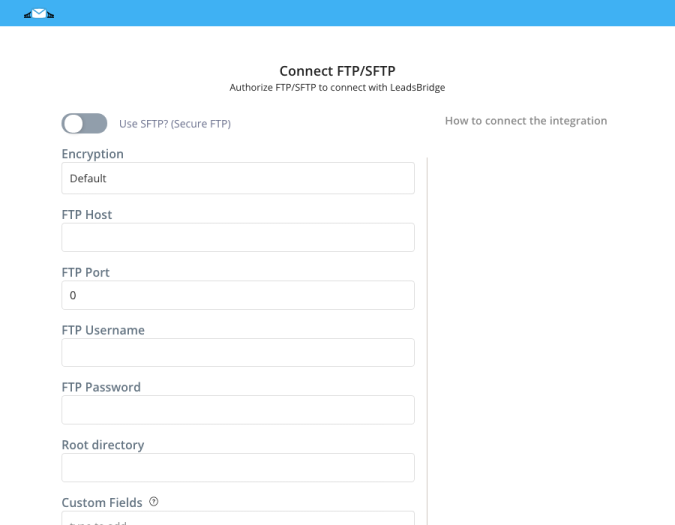Integrate FTP/SFTP with LeadsBridge
Intro
The File Transfer Protocol (FTP) is a standard protocol used to transfer files from/to a server. With this integration, you will be able to sync leads with your server through an FTP/SFTP connection.
In this article, you'll learn how to connect your LeadsBridge account with FTP/SFTP.
Connect FTP/SFTP integration
Before you start
- Head over to the left sidebar and click on the Create new Bridge button
- Select your integrations in the selectors
- Click on the Continue button at the bottom right
Authorize FTP/SFTP integration
Setup your FTP/SFTP integration
- Click on Connect FTP/SFTP
- Click on Create new integration to connect your FTP/SFTP (or select an existing one from the dropdown if you already connected it)
- A popup wil be opened where you can authorize the FTP/SFTP integration
- Fill Use SFTP? (Secure FTP), FTP Host, FTP Port, FTP Username, FTP Password, Root directory, Destination filename pattern, Private Key, Charset, File's extension (eg. txt), Fields Separator Char, Headers row number (default 0) field to connect FTP/SFTP with LeadsBridge
- Click on the Authorize button
- You can choose a name for this FTP/SFTP and LeadsBridge integration (you can also edit it later)
- Once done, click on Continue button and you will get back to the bridge experience where you could choose additional integration settings
- Now that your FTP/SFTP is connected, you can continue with the set-up of your bridge


Configuration details for FTP/SFTP
How to get Use SFTP? (Secure FTP), FTP Host, FTP Port, FTP Username, FTP Password, Root directory, Destination filename pattern, Private Key, Charset, File's extension (eg. txt), Fields Separator Char, Headers row number (default 0)
Some FTP/SFTP details such as host name, username and password are required for accessing your files on the server by using an FTP client. The FTP details will comprise a server address (similar to ftp.yourdomain.com), a username and a password.
In case that you don't have, or you don't know, those details, you should contact your web hosting provider, and they will be able to give you this information.
Usually, web hosting services provide you these details after you sign up for a web hosting package. In most cases you’ll receive your FTP/SFTP information details in the welcome email sent from your web host provider after signing up to their services.
Below you can find a short description for each field from the FTP/SFTP integration:
In case that you don't have, or you don't know, those details, you should contact your web hosting provider, and they will be able to give you this information.
Usually, web hosting services provide you these details after you sign up for a web hosting package. In most cases you’ll receive your FTP/SFTP information details in the welcome email sent from your web host provider after signing up to their services.
Below you can find a short description for each field from the FTP/SFTP integration:
- Use SFTP This toggle will allow you to use the Secure mode (SFTP), if your FTP server implements it
- FTP Host This is the hosting server name
- FTP Port This is the server port, the default port for FTP is 21, and for SFTP is 22
- FTP Username/Password Your FTP credentials, usually they're the same as your cPanel login details
- Root Directory This is the folder in your FTP service where you would read files from or put files to. If any provided, the root dir will be used
- Headers row number This is the row index (0 based) in which the file headers are located
- Charset This is the charset encoding of your input files
- File's extension This is the extensions that will be used to filter files in case you use your integration as a Source
- Fields Separator Char The char used as separator in the CSV file
- Destination filename pattern This value will be used to define the name of the output file in case the integration is used as Destination. You may use Date and Time patterns chars such as Y/m/d H:i:s. Notice that you should type the pattern inside square brackets, for instance [Ymd]
How to get File's extension (eg. txt)
Please note that when used as Source FTP/SFTP, it only accepts .csv and .xls files. When used as Destination the integration only accepts .csv
Which entity concepts we support for FTP/SFTP
With LeadsBridge you may use these entity concepts for FTP/SFTP.
Record
The data related to a Lead, Contact, Order, Product or any other type of item that you could integrate inside LeadsBridge.
Which segmentation concepts we support for FTP/SFTP
With LeadsBridge you may use these segmentation concepts for FTP/SFTP.
File
A data file is any file that contains information and it is meant to be read or viewed and not executed. It may contain the settings of a program that tells how to display information.
Common questions for FTP/SFTP
How does the FTP/SFTP integration work when used as Source?
When used as Source, LeadsBridge will scan the root directory and search for files with the specified data extension (usually .csv or .xlsx files).
Each file will be seen as a different list inside the bridge settings.
The first row of your file should contain the headers, anyway if it is different you could configure it using the field Headers row number (default 0)
For best results, please format your file with the following syntax:
[code]“EMAIL”;”FIELD1″;”FIELD2″;”FIELD3″; and so on…[/code]
For instance:
[code]“Email”;”Name”;”Gender”;”Phone”;”Make”;”Model”;
“test@leadsbridge.com”;”Test Lead”;”Male”;”011999999″;”BMW”;”i8″;
"john@gmail.com";"John Paul";"Male";512345678";"Tesla";"Model S";[/code]
How does the FTP/SFTP integration work when used as Destination?
LeadsBridge will create a file, into the root directory, with the extension specified inside the field Destination filename pattern of the integration settings (typically .csv files). It can be a file for each lead or a daily file depending on the Datetime pattern inserted.
The file format depends on the Custom Fields that you add in the integration settings, those will be used as the Destination fields inside the Bridge's Fields Mapping step
To add Custom Fields, you should do the following:
1. Head to your FTP Integration settings
2. Type the Custom Field name
3. Then press Enter
4. Repeat steps 2 and 3 until you’ve entered each field name you'd like to add
5. Finally, click on Finish
It can be useful if you have a CRM/system that automatically reads the file and imports the data based on the fields used.
What happens if during some days I don't receive any leads from my source?
The file is created when the first lead comes into the bridge, so if during a specific day you didn't receive any leads in your source, the file won't be created.
Which are the LeadsBridge IPs that need to be whitelisted?
You can check which IPs need to be whitelisted on our dedicated documentation at the following link:
( Learn more)
How does the integration create the file Headers when used as Destination?
The integration FTP/SFTP will create a header in the final file when used as Destination for each field created in the Integration's Custom Fields property.
Which is the order of mapped custom fields when used as Destination ?
In the final CSV file, columns will be ordered following the same order of the mapped custom fields set in the integration configuration.
Why I get a connection error during my FTP/SFTP integration authentication?
Be sure that you have set the right FTP Port on your Integration configuration. Remember that the default FTP port is 21, and that if you’re using SFTP the default is 22, if your Port looks like 2222 or 4444 is highly probable that you’re using SFTP, because the sysadmins often change the SSH port to a higher one for security reasons.
Why I can't see my file in the segments list when the integration is used as Source?
The list of files in the segmentation settings is collected using 2 types of filters:
1. Getting only files with the configured extensions
2. Getting only files with a size equals or less than 20 MB.
If you need to use a file with a greater dimension please contact us at support@leadsbridge.com we will be glad to help you.
How can I distribuite my leads in a single or multiples files when used as Destination?
Thanks to the field Destination filename pattern you can distribute your leads in a single file, a daily file or in multiple files for each lead.
Indeed, LeadsBridge will generate a file with the name using the configured pattern and the date and the time when the lead is synchronized.
For example:
1. If you want to have a single file with all your leads, you can insert a fixed filename without any pattern like MyLeads.csv
2. If you want to have a single file with the leads that have been collected daily, you can use a pattern that includes the d char in order to change the name daily and don't include any His chars which represent the time values, for instance MyDailyLeads_[Ymd].csv
3. If you want to have each leads in a single file, you can use a pattern that includes the time pattern His char, in order to change the name each second, something like MyDailyLeads_[Ymd_His].csv
The behavior of the application is that, once generated, the name of the file is based on the sync time, if the file already exists in your FTP/SFTP repository, the new lead will be appended to that file, otherwise a new file will be created from scratch.
Why I can't find any field in the Fields Mapping when used as Source?
The FTP/SFTP integration, when used as Source, tries to identify the Headers of the file in the first row by default.
If your file has the Headers row in a different location due to some pre-Headers, you can set the actual number of the Headers row in the integration settings, using the field Headers row number (default 0).
Notice that the inserted value should be 0-based, this means that the first row is the value 0, the second row is the value 1 and so on.
Do you need help?
Here some additional resources:
- LeadsBridge KNOWLEDGE BASE
- Contact support from your account clicking on the top right Support button

